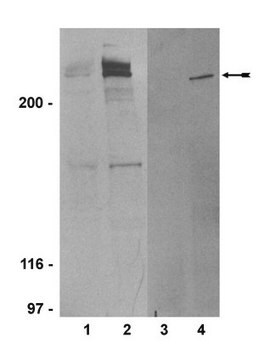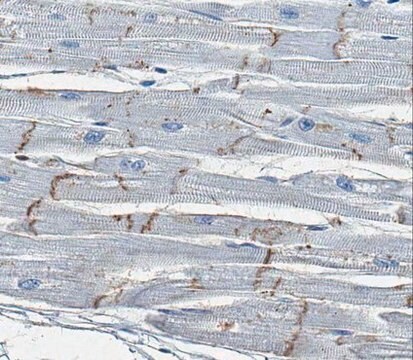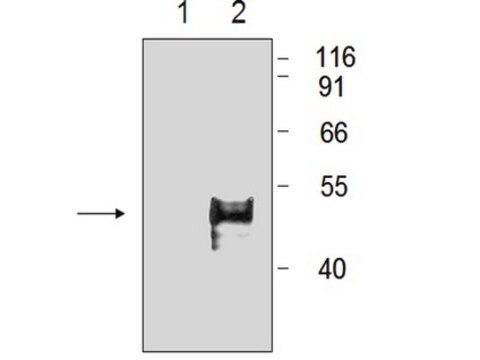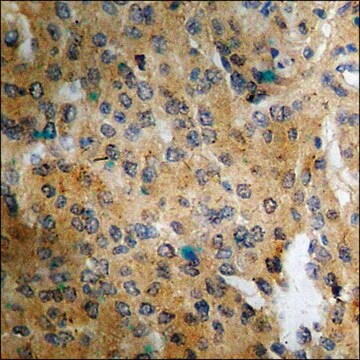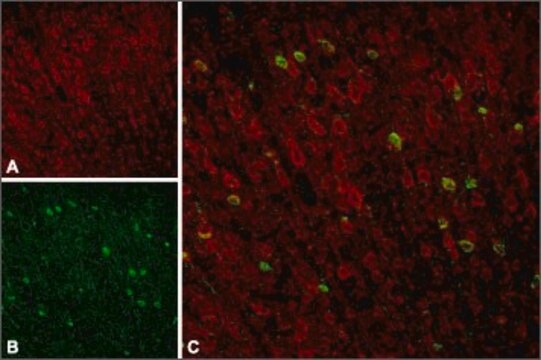추천 제품
생물학적 소스
rabbit
Quality Level
항체 형태
saturated ammonium sulfate (SAS) precipitated
항체 생산 유형
primary antibodies
클론
polyclonal
정제법
affinity chromatography
종 반응성
human, mouse
제조업체/상표
Chemicon®
기술
immunocytochemistry: suitable
immunohistochemistry: suitable
NCBI 수납 번호
UniProt 수납 번호
배송 상태
dry ice
타겟 번역 후 변형
unmodified
유전자 정보
human ... RAD54L(8438)
특이성
Recognizes RAD54L. The molecular weight of the protein is 84,326 Daltons.
면역원
Synthetic peptide, amino acids 12-27 of RAD51L.
애플리케이션
Anti-Rad54L Antibody is a high quality Rabbit Polyclonal Antibody for the detection of Rad54L & has been validated in ICC & IHC.
Immunohistochemistry: 1:200-1:1,000.
Immunocytochemistry: 1:200-1:1,000.
Optimal working dilutions must be determined by the end user.SUGGESTED PROTOCOL FOR IMMUNOHISTOCHEMISTRY
1. Dissect tissues and freeze on dry ice
2. Cut on a cryostat - 10um slices
3. Dry slides at room temperature for 30-90 min
4. Fix with cold Acetone/Methanol (50/50) 2 min - then either process further or store at -20°C . Alternative is fixation with 4% PFA and treatment with a trypsin solution. (0.05% trypsin , incubation 10 minutes at 37°C, followed by 3 washes with PBS)
5. Let air dry
6. PBS 5min
7. Incubate in 50mM ammonium chloride 30 min
8. PBS 5min
9. Blocking serum 30-45min
10. Primary antibody 90min - dilution 1:100 - 1:600
11. Wash 3 times for 5 min
12. Secondary fluorescent conjug. antibody 30min
13. Wash 3 times for 5 min and mount
Immunocytochemistry: 1:200-1:1,000.
Optimal working dilutions must be determined by the end user.SUGGESTED PROTOCOL FOR IMMUNOHISTOCHEMISTRY
1. Dissect tissues and freeze on dry ice
2. Cut on a cryostat - 10um slices
3. Dry slides at room temperature for 30-90 min
4. Fix with cold Acetone/Methanol (50/50) 2 min - then either process further or store at -20°C . Alternative is fixation with 4% PFA and treatment with a trypsin solution. (0.05% trypsin , incubation 10 minutes at 37°C, followed by 3 washes with PBS)
5. Let air dry
6. PBS 5min
7. Incubate in 50mM ammonium chloride 30 min
8. PBS 5min
9. Blocking serum 30-45min
10. Primary antibody 90min - dilution 1:100 - 1:600
11. Wash 3 times for 5 min
12. Secondary fluorescent conjug. antibody 30min
13. Wash 3 times for 5 min and mount
Research Category
Epigenetics & Nuclear Function
Epigenetics & Nuclear Function
Research Sub Category
Cell Cycle, DNA Replication & Repair
Cell Cycle, DNA Replication & Repair
물리적 형태
Precipitated antibody in a solution of 50% saturated ammonium sulfate and PBS containing no preservatives.
PREPARATION AND USE: To reconstitute the antibody, centrifuge the antibody vial at moderate speed (5,000 rpm) for 5 minutes to pellet the precipitated antibody product. Carefully remove the ammonium sulfate/PBS buffer solution and discard. It is not necessary to remove all of the ammonium sulfate/PBS solution: 10 μL of residual ammonium sulfate solution will not effect the resuspension of the antibody. Do not let the protein pellet dry, as severe loss of antibody reactivity can occur.
Resuspend the antibody pellet in any suitable biological buffer, standard PBS or TBS (pH 7.3-7.5) are typical. Volumes required are not critical but it is suggested that the final antibody concentration be between 0.1 mg/mL and 1.0 mg/mL. For example, to achieve a 1 mg/mL concentration with 50 μg of precipitated antibody, the amount of buffer needed would be 50 μL.
Carefully add the liquid buffer to the pellet. DO NOT VORTEX. Mix by gentle stirring with a wide pipet tip or gentle finger-tapping. Let the precipitated antibody rehydrate for 1 hour at 4-25C° prior to use. Small particles of precipitated antibody that fail to resuspend are normal. Vials are overfilled to compensate for any losses.
PREPARATION AND USE: To reconstitute the antibody, centrifuge the antibody vial at moderate speed (5,000 rpm) for 5 minutes to pellet the precipitated antibody product. Carefully remove the ammonium sulfate/PBS buffer solution and discard. It is not necessary to remove all of the ammonium sulfate/PBS solution: 10 μL of residual ammonium sulfate solution will not effect the resuspension of the antibody. Do not let the protein pellet dry, as severe loss of antibody reactivity can occur.
Resuspend the antibody pellet in any suitable biological buffer, standard PBS or TBS (pH 7.3-7.5) are typical. Volumes required are not critical but it is suggested that the final antibody concentration be between 0.1 mg/mL and 1.0 mg/mL. For example, to achieve a 1 mg/mL concentration with 50 μg of precipitated antibody, the amount of buffer needed would be 50 μL.
Carefully add the liquid buffer to the pellet. DO NOT VORTEX. Mix by gentle stirring with a wide pipet tip or gentle finger-tapping. Let the precipitated antibody rehydrate for 1 hour at 4-25C° prior to use. Small particles of precipitated antibody that fail to resuspend are normal. Vials are overfilled to compensate for any losses.
저장 및 안정성
Maintain unopened vial at -70°C for up to 6 months. Avoid repeated freeze/thaw cycles.The rehydrated antibody solutions can be stored undiluted at 2-8C° for 2 months without any significant loss of activity. Note, the solution is not sterile, thus care should be taken if product is stored at 2-8C°. For storage at -20C°, the addition of an equal volume of glycerol can be used, however, it is recommended that ACS grade or higher glycerol be used, as significant loss of activity can occur if the glycerol used is not of high quality.For freezing, it is recommended that the rehydrated antibody solution be further diluted 1:1 with a 2% BSA (fraction V, highest-grade available) solution made with the rehydration buffer. The resulting 1% BSA/antibody solution can be aliquoted and stored frozen at -70C° for up to 6 months. Avoid repeated freeze/thaw cycles.
법적 정보
CHEMICON is a registered trademark of Merck KGaA, Darmstadt, Germany
면책조항
Unless otherwise stated in our catalog or other company documentation accompanying the product(s), our products are intended for research use only and are not to be used for any other purpose, which includes but is not limited to, unauthorized commercial uses, in vitro diagnostic uses, ex vivo or in vivo therapeutic uses or any type of consumption or application to humans or animals.
적합한 제품을 찾을 수 없으신가요?
당사의 제품 선택기 도구.을(를) 시도해 보세요.
Storage Class Code
12 - Non Combustible Liquids
WGK
WGK 2
Flash Point (°F)
Not applicable
Flash Point (°C)
Not applicable
시험 성적서(COA)
제품의 로트/배치 번호를 입력하여 시험 성적서(COA)을 검색하십시오. 로트 및 배치 번호는 제품 라벨에 있는 ‘로트’ 또는 ‘배치’라는 용어 뒤에서 찾을 수 있습니다.
Daniel R Chang et al.
Proceedings of the National Academy of Sciences of the United States of America, 110(45), 18042-18051 (2013-09-24)
Mammalian organs, including the lung and kidney, often adopt a branched structure to achieve high efficiency and capacity of their physiological functions. Formation of a functional lung requires two developmental processes: branching morphogenesis, which builds a tree-like tubular network, and
Denise Martinez Alanis et al.
Nature communications, 5, 3923-3923 (2014-06-01)
The lung is a branched tubular network with two distinct compartments--the proximal conducting airways and the peripheral gas exchange region--separated by a discrete boundary termed the bronchoalveolar duct junction (BADJ). Here we image the developing mouse lung in three-dimensions (3D)
자사의 과학자팀은 생명 과학, 재료 과학, 화학 합성, 크로마토그래피, 분석 및 기타 많은 영역을 포함한 모든 과학 분야에 경험이 있습니다..
고객지원팀으로 연락바랍니다.

